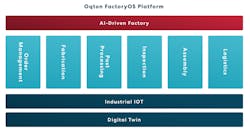How Digital Manufacturing Must Combine the Best of Tech with Skill
At a talk on smart factories, the presenter mentioned a full-digital thread. Then he asked the audience, “How many people here see the benefits of digital manufacturing?” Everyone held up their hands. Then the presenter asked, “How many of the hands that are up are currently using smart IoT digital manufacturing solutions?” Everyone’s hand went down. In the following Q&A, Ben Schrauwen CTO and co-founder of Oqton, talks about the skills manufacturers need, pitfalls to watch for, and how to get take a step into intelligent manufacturing.
What technologies are reinventing the manufacturing industry right now? Are there specific verticals associated with these technologies?
It’s broadly agreed that manufacturing is being reinvented through digitalization: new software technologies for design, simulation, and automation; the Industrial Internet of Things (IIoT); and methods and geometries made possible through additive manufacturing. The potential is to change the paradigm of manufacturing from mass production—which has dominated the industry for over a hundred years—to mass customization, small batches, or batch-size-of-one produced at a similar cost and efficiency as mass-produced goods. Industries like medical and dental devices, automotive, and aerospace batch sizes are already small, and there’s a lot of room for the optimization that these technologies can provide. That is why these verticals are already taking advantage of these technologies. I believe that industrial machinery is poised to be the next vertical disrupted.
What skills/labor are needed to implement and run these technologies?
Manufacturing jobs are challenged by a perception of being “dirty, dangerous, and dumb.” In a digitalized manufacturing world, the software and analytical skills needed are similar to those required in other digital industries. A challenge that manufacturing needs to overcome is attracting new talent that isn’t even aware that manufacturing is a great place for their skillset. Technologies such as additive manufacturing require very specialized expertise and are challenged by a limited labor pool. Training cycles are also long—a training program for metal 3D printing can be six months or longer. But software can and should help fill this gap just as it has in other industries, providing automated expertise and reducing the specialization burden on the human operator.
What manufacturing disciplines stand to benefit the most from these technologies?
The impact of digitalization is broad and will touch all manufacturing disciplines. Artificial intelligence (AI) can add value from design to engineering to production and management in making smart decisions based on simulated models and current and historical data. AI can do the heavy data crunching faster, easier, and with more variables than a human can, and offer up smart recommendations. Human experts then can use those recommendations to make decisions and implement change. Another side effect is that because digitalization is connecting these previously siloed manufacturing disciplines, they’ll be required to collaborate more, which benefits everyone, as well as improves manufacturing efficiency and agility.
Ben Schrauwen
How can manufacturers take a page from other modern industries?
Manufacturers could benefit from some of the same changes in thinking that have revolutionized retail. Amazon changed the game in a lot of ways, but in particular their data-driven decision-making approach is one that would benefit manufacturers. They use AI extensively, and leverage data to agilely make a large number of decisions that impact and improve the experience on an individual level, vs. making a few big decisions that are applied unilaterally.
What are some common pitfalls manufacturing leaders experience when implementing new technologies?
The challenges always come down to reducing risk and cost. Manufacturing leaders who negotiate this process best are those that carve out places in their organization for safe experimentation, with the intent that the learnings and advances can then be scaled. Apply new technologies and practices to a new product or production line, instead of the main production line. Ripping out and replacing technology is a big risk—but not upgrading will leave you behind, so finding a safe way to experiment is key.
How soon do they need to consider modernizing their factories?
Most manufacturers I’ve talked to have already been considering modernizing. The challenge is figuring out what to do next. The advice I give to prepare for a fully digitized future is to start collecting and archiving all the data you can, and work on connecting that data. It’s also critical to modernize your team’s soft skills, train them to learn and reward them for experimenting. One of the things we are doing with FactoryOS is building AI into the factory operating system to provide data-driven recommendations to human operators of what could be experimented with and tested to improve efficiency. A/B testing is common practice in other industries, but manufacturing is behind the times because experimentation is expensive. Pairing AI-driven recommendations with human experts will be the new agile manufacturing workflow.



